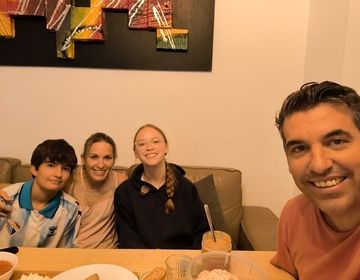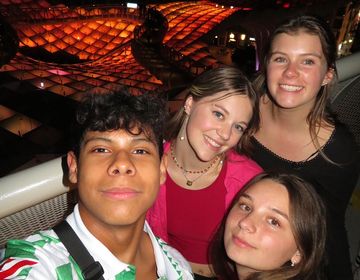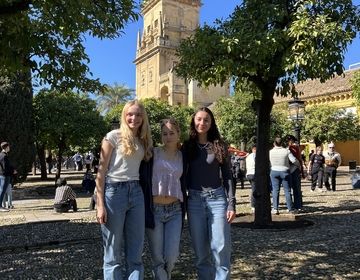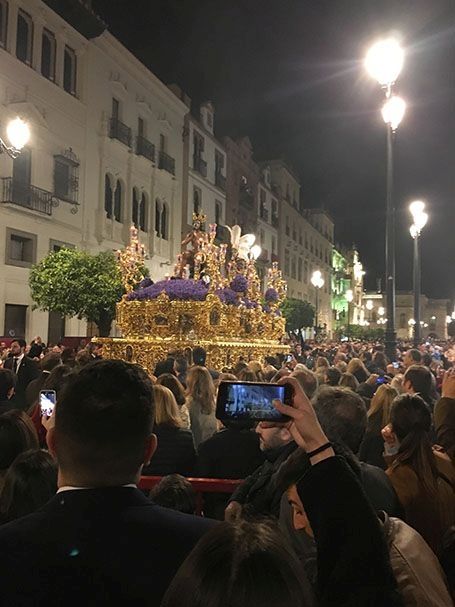Semana Santa
The past week has been the Semana Santa (Holy Week) here in Sevilla. Everyone had been hyping it up to me since I've been here saying that it was one of the most important parts of Sevillano culture. My host dad, who is a passionate member of 3+ brotherhoods, had shown me video after video after video (after video) of these "pasos" which are basically these big wooden floats which show gold, silver, and wooden carvings of Jesus and the Virgin Mary. They are decked out in flowers and candles and carried by about 40 men. These pasos are carried around in processions through every street in Sevilla's center and the surrounding villages.
I had prepared for the city to be busy with tourists from all across Spain (and the world) to experience the Sevillan Holy Week, but nothing prepared me for just how many people there were. People take this thing so so so seriously. These pasos go on 24 hours a day for a week straight. One night, I stayed out with my host mom until 6 a.m. to watch the Madrugá (the most important night of pasos). And we went home on the early side! Many of my friends didn't get home until 9 a.m., and some decided that they wanted to stay out watching pasos until 2 p.m. the next day (this further confirms my theory that Spanish people don't need sleep, but that's a whole other subject in itself).
I would be lying if I said that watching these pasos didn't get boring at times. As amazingly beautiful as they are, usually about a few hours in my feet would start hurting, I would get tired, bored, and all of the processions and pasos would start to look the same. Something I noticed is that most Spanish people are SO INTO IT. They carry around little books showing the schedules of the pasos and where they're going. They meet up with friends, dress to the nines, and watch paso after paso after paso after paso. It was so interesting to see just how passionate they are to watch these things.
On one of the last nights, as a paso was being carried through the streets of my town, I was feeling a bit "over it" if that makes sense. The minutes began to add up and I was definitely ready to go home for the night. Then I saw, standing in the doorway of a home, an old woman. She was holding a red flower up to her heart. The flower had come from the paso depicting the death of Jesus. Tears streamed down her wrinkled face as she watched the procession make its way down the street.
I asked my host dad, "¿por que esa mujer esta llorando? – why is that woman crying?" His response was one that I'll never forget: "She's crying because she knows that this is the last paso she will ever see. She's thanking the Lord for allowing her to live a full life." That was when I came to realize just how important this holiday is to Spanish people. Although I am neither Spanish nor Christian, in that moment I began to feel the meaning of these pasos. It's more than just a religious procession: It's a unique and powerful tradition that Sivillanos hold dearly to their hearts. It shows how deeply routed Spanish culture is. Though there are things about this culture that I never seem to understand, that's okay. It's bigger and a whole lot older than me. These pasos have been going on for centuries. This symbol of faith and tradition is so important to them because it is part of them. And I feel beyond grateful that now, the pasos have become a part of me and my own life. That's the beauty of learning from another culture.
Related Posts

How Studying Abroad Changed My Life
This post is student written by Beatrix D. who participated in an High School Abroad Fall Trimester in Spain! I never quite imagined myself eating tomato and garlic rubbed on... keep reading

How My High School Semester Abroad Has Helped Me Become Multilingual
This post was written by CIEE Global Navigator alum Fiona K. from Massachusetts who participated in the Global Navigator Marketing Internship in spring of 2025. "Stand up if you are... keep reading

Why I Left My Small Town in Alaska to Attend High School in Seville
This post was written by CIEE Global Navigator alum Makena D. from Alaska who participated in the Global Navigator Marketing Internship in spring of 2025. Living in a new city... keep reading
